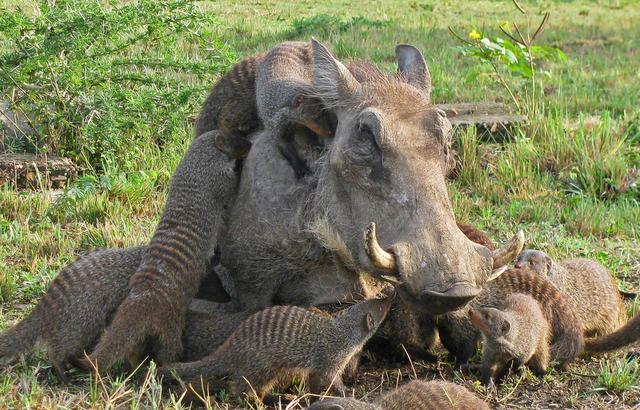(单词翻译:单击)
听力文本
This is Scientific American — 60-Second Science. I'm Jason G. Goldman.
Got a minute?
Mutual relationships are common throughout the animal kingdom. Fish called remoras get a tasty meal by picking bits of dead skin and parasites off of sharks, while the sharks enjoy their undersea spa treatment. Birds called oxpeckers gobble ticks off the skin of rhinos and zebras. Pollinators like bees and butterflies help flowers to reproduce while getting a tasty treat.
And now we have evidence for an unusual mutual relationship—between warthogs and banded mongooses.
Packs of mongooses will pile onto warthogs to pick blood-filled ticks and other parasites from the warthogs' fur. The hogs get cleaned up while the mongoose get fed. Everybody wins—well, except for the ticks.
"Quite often the warthog will then lie down and actually lift its legs, and they'll swarm all over them. In these groups you've got 15 to 20 individuals and they can just cover the warthogs."
Wildlife Conservation Society researcher Andy Plumptre, who documented the warthog-mongoose mutualism in Uganda's Queen Elizabeth National Park. He published his observation in Suiform Soundings, the newsletter of the International Union for Conservation of Nature's Specialist Groups for Wild Pigs, Peccaries, and Hippos.

Mutualism is obviously common in nature, but it's uncommon to find it between two different mammal species.
"I've heard once of somebody who saw a red-tailed monkey grooming a juvenile chimpanzee...and after the article came out, somebody contacted me and said they'd seen vervet monkeys grooming impalas."
So such behavior obviously does occur among mammals, but seemingly rarely. And the warthog-mongoose connection is the first example we know of that does not include a primate.
"So the mongoose researchers, they're all aware about it and will happily tell you about it, but nobody seems to have picked it up as a topic of research and actually looked at it in more detail."
For example, it's unclear if the interaction is instinctive or must be learned, whether it only occurs at certain times of year and so on. Given how long folks have been observing African wildlife, this begs the question: what other surprising animal behaviors are hiding in plain sight, waiting to be formally described in the scientific literature?
Thanks for listening Scientific American — 60-Second Science Science. I'm Karen Hopkin.
参考译文
这里是科学美国人——60秒科学。我是杰森·古德曼。
有一分钟时间吗?
动物王国的相互关系很常见。短鮣这种鱼类将鲨鱼身上的死皮和寄生虫当作美味的食物,而鲨鱼则很享受这种海底水疗。牛椋鸟这种鸟类食用犀牛和斑马皮肤里的虱子。蜜蜂和蝴蝶这种传粉昆虫帮助花朵繁殖,同时得到花粉。
现在有证据表明疣猪和条纹猫鼬之间存在不同寻常的相互关系。
猫鼬以疣猪皮毛里的充血虱子和其它寄生虫为食。猫鼬吃饱以后,疣猪身上也干净了。大家都是赢家,嗯,除了虱子以外。
“疣猪会经常躺下,把腿抬起来,然后猫鼬就会开始寻找疣猪全身上下的虱子。一般有15到20只猫鼬一起行动,它们几乎能覆盖住疣猪。”
野生动物保护协会研究员安迪·普伦普特里在乌干达伊丽莎白女王国家公园记录了疣猪和猫鼬的互利共生现象。他将他观察到的情况发表在国际自然保护联盟猪专家小组的简报《Suiform Soundings》上。
互利共生在自然界很常见,但是两种不同哺乳动物之间的共利共生现象却很罕见。
“我听说有人看到一只红尾猴为一只幼年黑猩猩理毛,这篇文章发表以后,有人联系我说,他们看到过黑长尾猴为黑斑羚理毛。”
所以,显然这种行为会在哺乳动物之间发生,只不过不太常见。猫鼬和疣猪之间的联系是我们知道的首个灵长类以外的例子。
“猫鼬研究员都知道这种联系,而且他们很乐于告诉你,但是好像没有人将这种联系选为研究课题,更深入地去研究。”
举例来说,目前并不清楚这种相互作用是本能还是后天学会的,也不知道这是否只在特定时间发生等等。从人们观察非洲野生动物的时间来看,这引出了一个问题:还有什么令人惊讶的动物行为隐藏在人们眼皮底下、等待科学文献去描述?
谢谢大家收听科学美国人——60秒科学。我是杰森·古德曼。
译文为可可英语翻译,未经授权请勿转载!
重点讲解
重点讲解:
1. clean up 把…弄干净;清理;
例句:You did a beautiful job of cleaning up the kitchen.
你把厨房打扫得真干净。
2. except for 除了;除…之外;唯有;
例句:Now the wood was silent except for the leave.
树林里一片寂静,只有树叶发出的响声。
3. pick up 挑选,选择;
例句:I think one would hesitate to pick up books like this in a normal retail space, which is why I did it online.
我认为,在普通的书店,不会有人毫无顾忌地选择这一类书,这就是我将书店搬到网络上的原因。
4. and so on 及诸如此类;等等;
例句:These cars vary in size, price, colour and so on.
这些汽车在大小、价格、颜色等方面各不相同。


